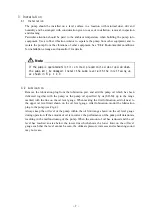
- 16 -
Firing hazard. As the surface of the pump body is higher temperature(40~80℃)
during operation, do not touch it until cooled down after stopping the pump.
4.7 Gas ballast valve
The pump is equipped with a gas ballast valve in order to evacuate vapor and condensable gases
such as solvent vapor.
Evacuated condensable gas that liquefies in the compression and pressurization processes of the
pump is mixed with the pump oil and starts circulating through the pump together with the oil.
In such a case, the same effect as when oil of a high steam pressure is used is produced, and the
ultimate pressure of the pump increases. Moreover, the lubricity of oil deteriorates and the
service life of the shaft seal is shortened.
If air or dry nitrogen enters through the gas ballast valve just before the compression and
pressurization processes of the pump, condensable gas will not liquefy and will be exhausted
together with air through the outlet valve. When the gas ballast valve is used, the “gas ballast
effect” increases as the pump temperature becomes high. So, before evacuating condensable gas,
perform operation for approximately 20 minutes with the gas ballast open, and after the pump
temperature reaches approximately
50
~
65
℃
, open vacuum valve (A) and continue operation
(see Fig.5). If the temperature is low, a satisfactory “gas ballast effect” is not achieved.
If the gas ballast valve is left open when condensable gas is not evacuated, not only does the
pump oil scatter and power is lost, but also the ultimate pressure increases. Furthermore, since
the gas ballast valve’s capacity to process condensable gas is limited, condensable gas remains
in the pump oil when a lot of condensable gas is exhausted or when condensable gas (air and
gas containing small amounts of moisture and other vapor which make the oil dirty) is
exhausted without opening the gas ballast valve. In such a case, perform non-load operation
with vacuum valve (A) closed and the gas ballast valve open. Then the oil temperature increases
and the pump oil is purified due to the effect of the gas ballast valve. Continue non-load
operation with the gas ballast valve closed until the specified pressure is reached. If the pump
oil is not cleaned even a long time, replace the pump oil.
As the surface of the pump body is high temperature (40~80℃) during operation,
do not touch it besides the gas-ballast valve.
Start operation after closing the gas-ballast valve.
If the gas ballast valve is left open without condensable gas being exhausted,
the pump oil scatters, power is lost, or the ultimate pressure increases.
Close the gas ballast valve when condensable gas is not exhausted.
Caution
Note
Caution
















































